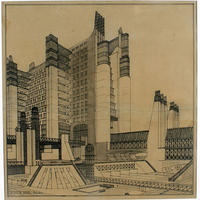More about Dynamic Hieroglyphic of the Bal Tabarin

Sr. Contributor
If you can get past the initial headache of looking at this painting by Gino Severini, you’re in for a treat.
Severini’s scene of the Bal Tabarin cleverly combines the frenetic energy of the Parisian dancehall with a few Easter eggs that are even more fun to find than some of Leonardo's hidden secrets. Try to find the following: a person in traditional Arab dress riding a camel, martini glasses, and a nude woman riding a pair of scissors. Severini liked to reference current events in his paintings, so the camel rider references the Turco-Italian War of 1911. Italy started this war in a bid to gain territory and conquer Turkish colonies in North Africa, setting into motion some of the tensions that sparked World War I. The martini glasses are evidence of the drinking and debauchery that happened inside the Bal Tabarin. They are also an homage to the Cubist still lifes that influenced Severini’s work, especially the work of his friends Georges Braque and Picasso. The elusive woman atop a pair of scissors might be there just because.
These surprises are so hard to find because Severini was a Futurist who dedicated his art to portray the chaos, energy, and movement of modern life. Naturally, he gravitated towards the scenes that he experienced in dancehalls like the Bal Tabarin, where women in bright, flouncy dresses twirled their nights away. Italian Futurism fused Cubist ideas and modes of representation with contemporary Italian political ideals, including their strong sense of nationalism. Severini refers to his nationalistic tendencies using the flags and pennants that adorn the picture’s background.
Despite the Futurists’ characteristic love for Italy, Severini lived in Paris and loved French art. He even urged his fellow Italian artists to learn from the strides that French artists were making at the time. This makes sense when you realize that the Futurists rejected tradition to move forward. They abhorred the dull, bourgeois morality of the nineteenth century – think the extremely polished Salon art of Bouguereau and Gerome. Parisian Cubists were at the cutting edge of rejecting the prevailing traditions of Western art, so the Futurists were definitely picking up what Picasso and company were throwing down.
Severini was neither the first nor the last artist to develop a fascination with the infamous Bal Tabarin. There are plenty of posters that advertised the place, and there’s even a 1952 movie musical all about it. For Severini, Paris had the perfect blend of innovative artists and a dancehall scene that kept him coming back for more. Even after forty years, he returned to his favorite subjects: dancers, light, and movement. Towards the end of his life in the 1950s, he began painting these lively scenes again.
Sources
- Arnason, H.H., and Elizabeth C. Mansfield. History of Modern Art. Upper Saddle River, NJ: Pearson Education, Inc., 2013.
- Encyclopedia Britannica. “Italo-Turkish War.” Events. https://www.britannica.com/event/Italo-Turkish-War. Accessed 24 June 2020.
- IMDB. “Bal Tabarin.” Titles. https://www.imdb.com/title/tt0044394/. Accessed 24 June 2020.
- Kramer, Charles, and Kim Grant. “Gino Severini, Dynamic Hieroglyphic of the Bal Tabarin.” Modernisms. Smarthistory. https://smarthistory.org/gino-severini-dynamic-hieroglyph-bal-tabarin/. Accessed 24 June 2020.
- Museum of Modern Art. “Dynamic Hieroglyphic of the Bal Tabarin.” Art and artists. https://www.moma.org/collection/works/79419?artist_id=5360&locale=en&pa…. Accessed 24 June 2020.
- Shaw, Gabbi. “Famous art with hidden images.” Insider. 19 September 2019. https://www.insider.com/hidden-images-in-art-2018-1. Accessed 24 June 2020.
- Solomon R. Guggenheim Foundation. “Gino Severini.” Collection Online. https://www.guggenheim.org/artwork/artist/gino-severini. Accessed 24 June 2020.
- WJY. “Bal Tabarin, San Francisco.” The New Found Photography. 18 August 2010. http://thenewfoundphotography.blogspot.com/2010/08/bal-tabarin-san-fran…. Accessed 24 June 2020.












